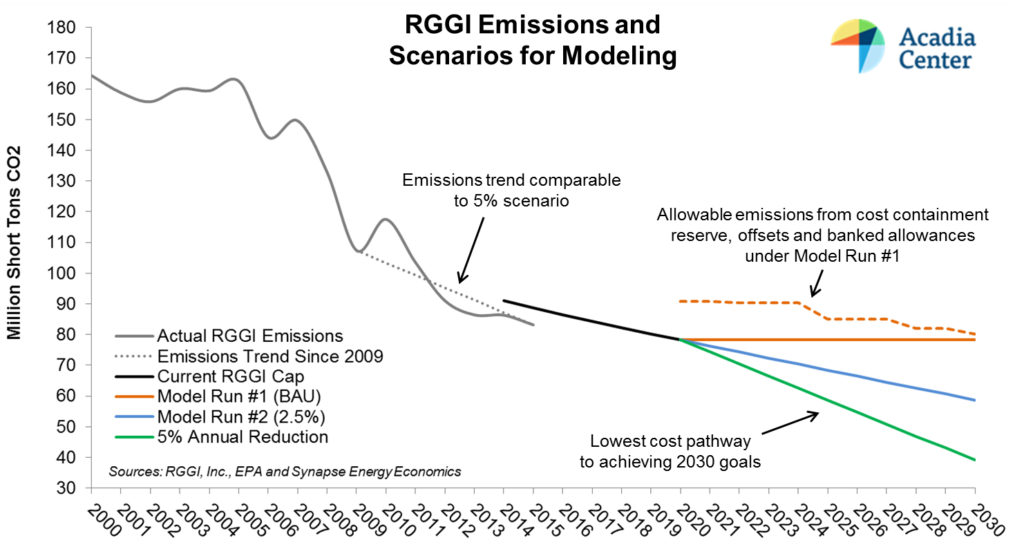RGGI modeling should be more expansive – environmental groups and power companies agree
Later this year, Northeast and Mid-Atlantic states will determine the future of the successful, first-in-the-nation climate program for the power sector, the Regional Greenhouse Gas Initiative (RGGI). The most important decision centers on the cap level, the primary indicator of the program’s environmental ambition. Before the RGGI states ultimately decide on a post-2020 cap level, however, they will model the impacts of a range of possible cap scenarios. It is with that range in mind that the Collaborative for RGGI Progress (“the Collaborative”) urged the RGGI states to broaden their proposed scope of modeling when they submitted comments last week.
The Collaborative is a unique coalition that includes two of the region’s largest power generators (Calpine and Exelon), one of the largest utilities (National Grid), and environmental organizations (Acadia Center and Natural Resources Defense Council). By finding common ground among diverse interests, the Collaborative seeks to propel balanced policy that advances RGGI states’ climate leadership.
At a February meeting in Delaware, the RGGI states proposed to model just two scenarios: one that reflects doing the bare minimum to comply with the requirements of the Clean Power Plan (see “Model Run #1” in the figure below), and a second that essentially continues the current RGGI cap trajectory of 2.5% per year through 2030 (see “Model Run #2” in the figure)¹. The Collaborative commends the RGGI states for modeling these two scenarios, but also requests the modeling of two more ambitious scenarios:
- A 5% annual reduction per year from the 2020 cap level from the electric sector from 2021 to 2030 (the green line in the figure); and
- A scenario that aligns electric industry emissions reductions with RGGI states’ shared commitment to 80% economy-wide GHG reduction targets by 2050.
The 5% annual reduction scenario would provide the states with more information on options for achieving deep, economy-wide emissions reduction commitments, and there is ample quantitative justification to model this specific scenario. As discussed in more detail in more detailed comments to RGGI, Inc. by NRDC, an annual 5% reduction from 2020-2030 would be on par with the actual emissions reductions that have occurred since RGGI began in 2009. RGGI has also generated billions of dollars in economic benefits since 2009, and modeling of a similar emissions reduction trajectory going forward will enable states to assess the impacts of continuing along a comparable glide path. RGGI modeling should also be used to evaluate the contribution that the program can make to achieve the RGGI states’ ambitious, long-term, economy-wide GHG reduction targets. A recent analysis from Synapse Energy Economics indicates that the most cost-effective pathway to achieving those targets translates to annual RGGI cap reductions of approximately 5% from 2020-2030. While the RGGI modeling will not encompass the building and transportation sectors – as Synapse’s analysis did – it affords an opportunity to evaluate how far the electric sector can go toward achieving multi-sector requirements.
This is not the first time that stakeholders have asked the RGGI states to model this 5% cap scenario; in previously submitted comments, environmental advocates, public health groups, clean energy companies and a representative of Fortune 500 businesses have all made compelling cases for the inclusion of this modeling run. However, these comments from the Collaborative represent the first time that RGGI compliance entities and electric utilities have weighed in to support this modeling.
The request is simple, the justification is clear, and the support is abundant. If the RGGI states intend to achieve their long term goals, they need to begin considering the pathways that will actually get them there. Modeling the impacts of a cap that declines by 5% of the 2020 level each year through 2030 is a key step in that process.
¹ From 2014 -2020, the cap declines annually by 2.5% of the preceding year’s cap level, while the proposed trajectory from 2020-2030 would be an annual decline of 2.5% from the 2020 level. The proposed 2.5% cap through 2030 would also eliminate the cost containment reserve and prohibit the use of offsets.
 Jordan Stutt is a Policy Analyst in Acadia Center’s Boston office. He works on energy, transportation and climate change issues, with an emphasis on research and policy analysis for energy systems and carbon markets. He was an Energy Policy Analyst at Pace Energy and Climate Center, Pace University Law School in White Plains, NY, where he focused on energy efficiency and RGGI.
Jordan Stutt is a Policy Analyst in Acadia Center’s Boston office. He works on energy, transportation and climate change issues, with an emphasis on research and policy analysis for energy systems and carbon markets. He was an Energy Policy Analyst at Pace Energy and Climate Center, Pace University Law School in White Plains, NY, where he focused on energy efficiency and RGGI.
 Peter Shattuck is Director of Acadia Center’s Massachusetts office and Clean Energy Initiative. Peter’s work at Acadia Center focuses on cleaning up the energy supply across all sectors of the economy. Driving market-based emissions reductions is at the core of this work, using cap and trade policies such as the Regional Greenhouse Gas Initiative, which Acadia Center has tracked since the program’s early development in the 2000s.
Peter Shattuck is Director of Acadia Center’s Massachusetts office and Clean Energy Initiative. Peter’s work at Acadia Center focuses on cleaning up the energy supply across all sectors of the economy. Driving market-based emissions reductions is at the core of this work, using cap and trade policies such as the Regional Greenhouse Gas Initiative, which Acadia Center has tracked since the program’s early development in the 2000s.
Forests and Climate Change – From Offsets to What?
In 1994 Greenpeace released a report called “The Carbon Bomb: Climate Change and the Fate of the Northern Boreal Forests”. The report warned that between 50 and 90 percent of the existing boreal forests were likely to disappear as a result of climate changes that would happen if atmospheric levels of carbon dioxide doubled. Warmer and drier conditions stress trees directly, as well as contributing to conditions that could lead to more frequent fires and pest outbreaks. If boreal forests continued to decline, they could release of up to 225 billion metric tons of extra carbon into the atmosphere, increasing current levels by a third.
The recent wildfires that have burned roughly 874,750 acres in Fort McMurray, Canada are a sign that the carbon bomb may be beginning to explode. An El Nino year contributed to a particularly dry winter, and record temperatures and low humidity this May set the stage for a brutal fire season. While individual occurrences of fires, just as individual occurrences of hurricanes, are impossible to tie to climate change, scientists agree that more frequent and intense fires on average are expected.
According to Natural Resources Canada, the boreal forest, or taiga, covers 3.7 billion acres, or which makes up a third of the world’s forests. It extends through Alaska and Canada in the Western hemisphere, and Scandinavia, Russia and northern Asia. In addition, boreal soils include large areas of permafrost and peatlands, which themselves can be large sources of carbon and methane, an even more potent greenhouse gas, if they breakdown through thawing or burning. Currently, more than 4.9 million acres of forest burn each year in Canada. This is twice the average area burned in the early 1970s.
 Forests play an incredibly important role in climate change internationally and nationally, but policy solutions have proven elusive in the United States. In May of 2008, Acadia Center (then Environment Northeast), Manomet and the Maine Forest Center, released recommendations for how to expand forest offset categories in the Regional Greenhouse Gas Initiative (RGGI). These recommendations outlined how, with rigorous measurement and verification, projects that decreased carbon emissions from logging and land development could be used to meet part of the emissions requirements of the program.
Forests play an incredibly important role in climate change internationally and nationally, but policy solutions have proven elusive in the United States. In May of 2008, Acadia Center (then Environment Northeast), Manomet and the Maine Forest Center, released recommendations for how to expand forest offset categories in the Regional Greenhouse Gas Initiative (RGGI). These recommendations outlined how, with rigorous measurement and verification, projects that decreased carbon emissions from logging and land development could be used to meet part of the emissions requirements of the program.
In 2013, the RGGI states released updated program rules which incorporated these new forest categories, harmonizing rules with a similar program in California. To date the low price of auction allowances has meant that no forest projects have been used to comply with RGGI. However, some forest offset projects located in the Northeast have been registered in the California carbon market, which has had much higher prices.
At the federal level, implementation of EPA’s Clean Power Plan, which aims to reduce carbon dioxide emissions from power plants in the US, has been stayed by the Supreme Court. If the program goes forward, it is expected that states that are already implementing emission reduction programs, such as RGGI, will be allowed to use these programs to comply with the federal program. The role of offsets in meeting EPA requirements remains uncertain.
Clearly, protecting the carbon stored in forests is essential to preventing a dangerous climate tipping point. However, the threats to forests from climate change itself, as shown in the fires raging around Fort McMurray, highlight that concerns over the permanence of carbon stored in forest projects were not misplaced.
Additional Reading
The Carbon Bomb: Climate Change and the Fate of the Northern Boreal Forests – by Greenpeace, 1994
Forest Future: The Role Forests Can Play in Addressing Climate and Promoting Sustainable Economies – by ENE (now Acadia Center), 2010
Turning Up the Heat: Global Warming and the Degradation of Canada’s Boreal Forest – by Greenpeace, 2008
 Ellen Hawes is the Senior Analyst, Energy Systems and Carbon Markets at Acadia Center. Ellen’s work as senior analyst focuses on energy systems, land use and carbon markets. She also leads Acadia Center’s participation in New Hampshire energy policy work. Ellen received her Master in Forestry from the Yale School of Forestry and Environmental Studies.
Ellen Hawes is the Senior Analyst, Energy Systems and Carbon Markets at Acadia Center. Ellen’s work as senior analyst focuses on energy systems, land use and carbon markets. She also leads Acadia Center’s participation in New Hampshire energy policy work. Ellen received her Master in Forestry from the Yale School of Forestry and Environmental Studies.
The Promise of Energy Storage: Making the Grid Operate Like Our Food System
To understand the transformative potential of energy storage in helping achieve a clean and efficient power grid, it helps to conduct a thought experiment: imagining if our food system worked like our power grid. Instead of warehousing surpluses from our farms and keeping refrigerators and pantries stocked with what we need at home, a massively overbuilt food delivery system would be needed to provide the exact amount of food needed to serve every human being, at every single moment of every day.
Illogical as it seems, that is how our electric grid functions, requiring electricity generation to match fluctuating demand on a minute-by-minute basis, 365 days of the year. With intermittent renewable energy sources such as wind and solar making up a greater portion of energy supply – essentially serving up local, cheap food at unpredictable times – the lack of storage has become untenable.
Advances in energy storage are needed to make our outdated grid more efficient, support the growth of renewable energy, and reduce consumer costs. Storage will allow us to preserve excess energy generated during periods of low demand (for example offshore wind produced at night) and use this energy to meet peak demand hours or days later. Drawing on stored energy will avoid the need to switch on the least efficient and most expensive fossil fuel-burning power plants, saving money for all electricity consumers. Energy storage can also reduce the need for more expensive upgrades to utility infrastructure, and improve resiliency by providing electricity in emergency situations. There is even greater promise in “stacking” all of these services – reducing peak power costs, avoiding infrastructure expenditures, providing backup power – and more, as described in a recent RMI paper.
The greatest impediment to achieving the benefits of energy storage has been high up-front costs, but this barrier is falling away. Costs for established technologies like the lithium-ion batteries in phones and electric vehicles are falling rapidly, and creative approaches have shown the viability of storing energy in compressed air, high-tech spinning tops called flywheels, and myriad new chemistries being cooked up in research labs and universities across the country.
Where it has been allowed to compete with conventional resources, storage is already excelling. In California, regulators determined that it would be cost-effective for utilities to bring 1300MW of storage online (about the size of New England’s largest, and soon-shuttering coal-fired Brayton Point power plant). As covered in UtilityDive, in an initial step toward that target, Southern California Edison (SCE) signed up 264MW diverse energy storage applications in 2013, far exceeding requirements for the first procurement. In a sign of the changing times, this energy storage even beat out natural gas power plants for the portion of the procurement meant to ensure adequate generating capacity.
In Massachusetts steps are being taken to unlock the potential for energy storage. The Baker Administration’s Energy Storage Initiative is providing $10 million in funding for storage deployments, and analyzing the market and economic development potential for energy storage. Energy storage will also likely feature in omnibus energy legislation, in the form of S1762, authored by Sen. Ben Downing, or a similar mechanism to enable the Department of Energy Resources to act on the findings of their studies. Opportunities for deploying energy storage in new ways – such as repowering Brayton Point with clean energy – are also helping to build support.
With more and more renewable energy coming online, and more clarity about the consumer and commercial benefits of developing energy storage, Massachusetts appears poised to take the next step in realizing the potential for energy storage. By cultivating and supporting innovative technologies and applications for energy storage we can make the electric grid more efficient and adaptable, allowing us to have our cake and eat it – whenever we want.

Peter Shattuck is Director of Acadia Center’s Massachusetts office and Clean Energy Initiative. Peter’s work at Acadia Center focuses on cleaning up the energy supply across all sectors of the economy. Driving market-based emissions reductions is at the core of this work, using cap and trade policies such as the Regional Greenhouse Gas Initiative, which Acadia Center has tracked since the program’s early development in the 2000s.
New York Grid Modernization Reforms Present Utilities with New Earnings Opportunities
New York State is in the midst of radically reforming its utility regulatory landscape— and eventually markets—to accelerate the integration of distributed energy resources (DERs) into the grid. DERs, like solar photovoltaics (PV) and energy efficiency, create opportunities for customers to manage their energy usage, improve power quality and resiliency, and help meet state clean energy and environmental goals. The radical reform all started in 2014 with the Reforming the Energy Vision (REV) initiative, which “aims to reorient both the electric industry and the ratemaking paradigm toward a consumer-centered approach that harnesses technology and markets.”
The Public Service Commission tasked with REV implementation has been considering a number of regulatory options to advance REV goals over the past two years. Earlier this year, the Commission held a technical conference focused on performance incentive tools – Earnings Impact Mechanisms (EIMs) and Market-Based Earnings (MBEs.)
Earnings Impact Mechanisms
Earnings Impact Mechanisms reward or penalize utilities for their performance with regard to certain targets, such as energy efficiency and peak demand reduction. The speakers noted that the mechanisms are one of the most effective and low risk regulatory tools and are crucial to achieving New York’s climate goals, but numerous questions remain about the exact EIM structure.
Clear guidelines and an adequate level of utility incentives are necessary for the EIMs to be effective, but at the same time, the mechanisms are meant only as a transition device to a future utility business model envisioned in REV and must not foster continued dependence.
The regulators should ultimately consider how EIMs fit into an overall utility revenue framework. If a utility hits an EIM performance target, it could earn a lump sum cash award or receive an adjustment to return on equity (ROE) basis points.¹ The former scheme is preferable according to the panel as an EIM tied to ROE is in direct conflict with the state’s strive to eliminate utilities’ incentive to favor capital expenditures. The EIMs must ultimately encourage utilities to utilize customer and third party capital to advance REV goals rather than grow their rate base. To further this objective, the Commission has also proposed a modified claw back mechanism that allows utilities to keep earnings on unspent capital as long as the reduction in capital spending is attributed to a distributed energy resource (DER) solution. In the absence of this provision, any reduction in capital spending would cut into utilities’ profits.
Besides the EIM design, the list of policy goals suitable for EIMs hardly gathered unanimous support from the panel. Joint Utilities argued that only metrics within utility control should have symmetrical as opposed to positive-only earnings impact – for instance, peak demand is subject to factors independent of utility actions, such as weather and economic activity in the service area. Joint Utilities also emphasized the need for revenue certainty and continued access to capital markets that may be jeopardized if utility earnings are at risk.
Market Based Earnings
Market Based Revenues represent an innovative revenue source for the utilities that offer services beyond their basic electric or gas service obligations. The discussion around MBEs focused on the composition and pricing of the utility value-added services. The Commission expects the utilities to earn platform service revenues (PSR) by virtue of serving as a distributed system platform (DSP) provider, an intermediary between consumers and third party DER sellers, as well as additional service-based revenues, such as advertising fees or engineering fees, for services that are available from either the utilities or third parties. The exact make up and structure of MBEs remain uncertain however and are largely explored through ongoing utility demonstration projects.
Panel participants proposed separate pricing approaches for PSRs and competitive MBEs. Considering utility’s monopoly position as a platform provider, using cost-based ratemaking for platform service fees to ensure nondiscriminatory and transparent rates is most appropriate. Conversely, competitive products and services that may be offered either by the utility or a third party should be market value priced upon comprehensive stakeholder input. In addition, consumers who choose to engage and take full advantage of the platform value-added services should bear the extra cost to prevent cost shifting to ratepayers who choose to limit their engagement with the platform.
Going forward Acadia Center will continue to closely monitor these discussions.
¹ The adjustment to basis points represents a change in the regulator-approved rate of return or profit a utility is allowed to earn on its rate base comprised primarily of its capital investments in long-term assets, such as transmission lines or power generation facilities.
Irina Rodina works as Staff Counsel for Acadia Center focusing on grid modernization and utility reform in New  York State. Irina has extensive experience in environmental and energy policy, including renewable project development and market issues, community energy development, sustainable agriculture, and climate change.
York State. Irina has extensive experience in environmental and energy policy, including renewable project development and market issues, community energy development, sustainable agriculture, and climate change.
What If We All Drove Electric Vehicles?
Electric Vehicles (EVs) are frequently discussed as an exciting new technology that will be able to dramatically lower transportation emissions in the region, while lowering costs to consumers. As battery costs continue to decline and technology improves, this promise looks closer than ever. The widespread adoption of EVs has another potential game-changing benefit – it could radically change the way we operate our electric system for the better.
The electric grid is built to ensure that the lights stay on during the times when electric usage is at its highest – generally summer afternoons during heat waves in this region. The rest of the time much of the infrastructure is being lightly used. Distributed Energy Resources (DER), sources of energy or energy conservation that are widely dispersed, offer the potential to change the way the grid is used and optimize the current physical infrastructure without needing to build more. Electric vehicles with 2-way connections to the grid could become a significant new DER. They could store energy when the grid is lightly taxed and feed it back onto the grid when it is most needed and could play a key role in offsetting the need to build large centralized power plants and transmission lines.
Acadia Center conducted an analysis to examine the potential impacts that EVs could have on the grid. We looked at the aggregate capabilities of switching every car in the New York / New England region to a Nissan Leaf. The Leaf is an all-electric vehicle, but its battery is relatively small compared to larger cars with greater range, which means this analysis did not look at the upper limits of potential. The Tesla Model S, for example, has a battery that has approximately three times more storage capacity than a Leaf. Switching all 10.5 million passenger cars in the New York and New England to 10.5 million Leafs would result in electric storage capacity of over 250 GWh. This is the equivalent of more than 30% of all electricity consumed in the region on an average day. The Leaf batteries would also have 850 GW of peak capacity, about 12 times more than all of the power plants in the region and 14 times more than the peak demand in the region during the highest-use hour on the hottest summer day of the year. Just tapping into a small portion of this battery capacity could dramatically reduce the need for new infrastructure in the region and could help smooth out the more variable production of renewable sources.
Jamie Howland leads Acadia’s  Climate & Energy Analysis Center (CLEAN), and Energy Efficiency and Demand Side Initiative. His work as a policy analyst focuses on data management on energy markets and emissions trends, buildings and land use issues.
Climate & Energy Analysis Center (CLEAN), and Energy Efficiency and Demand Side Initiative. His work as a policy analyst focuses on data management on energy markets and emissions trends, buildings and land use issues.
First in a Series of Acadia Center Community Energy Forums a Success
Last week Acadia Center hosted a Community Energy Forum in Westport, Connecticut. The forum raised awareness and helped educate participants about Acadia Center’s three reports EnergyVision, UtilityVision, Community|EnergyVision, and the clean energy revolution currently taking place.
The new ways we generate, deliver, and use energy offer communities and neighborhoods exciting opportunities to benefit from clean, efficient, and affordable energy at the local level and move away from increasing their overreliance on fossil fuels. However, reforming our existing and outdated utility model is necessary to enable these transformative community energy projects to flourish.
Speakers at the event included: Jamie Howland, Director, Energy Efficiency and Demand-Side Initiative, Acadia Center; Peter Boyd, Founder & CEO, Time4Good, and Member of the Green Task Force; and Mark Robbins, President, MHR Development, Clean Energy & Infrastructure Solutions. The panel of speakers discussed Acadia Center’s Community|EnergyVision publication – a comprehensive framework that outlines a pathway for communities to take control of the energy system, community energy efforts in Westport, and challenges of developing clean energy projects at the local level. Boyd, a Westport resident, talked about the importance of Net Zero, producing as much energy as you use, and Westport’s recent goal to become a Net Zero community by 2050. Robbins, a Westport businessman, spoke about his experiences developing community clean energy projects and the policy challenges he faced.
After learning about community energy and the importance of investing in local clean energy initiatives, participants engaged with a map of Westport helping to visualize these local, clean energy innovations within their community. Participants placed stickers representing various community energy initiatives (e.g. Community Solar, Microgrids, Storage, etc) onto the map of Westport at locations within the community like schools, the Town Hall, and the train station.
Westport Now, a local news outlet also covered the event with a great piece here.
The Westport Community Energy Forum is the first in a series of Community Energy Forums Acadia Center is planning to hold throughout Massachusetts, Connecticut, and Rhode Island seeking to educate and increase support for energy issues at the local level while working towards state level policy changes needed to enable community energy.

Tyler Soleau is Acadia Center’s Energy and Climate Outreach Director working from the Boston office. He focuses on raising awareness, network building and advancing Acadia Center’s clean energy program goals in Massachusetts and the Northeast. Tyler came to Acadia Center from the Massachusetts House of Representatives where he served most immediately as Staff Director and Counsel for the House Committee on Climate Change.
Remaking Connecticut’s Energy System to Embrace Community Energy Agenda
Westport Town Hall Auditorium
March 21, 2016
7:05 pm Welcome & Introductions Tyler Soleau, Outreach Director, Acadia Center
7:15 Expert Session – How Community|EnergyVision help Connecticut communities better manage their energy needs?
An emerging revolution in the ways we generate, deliver, and use energy offers new and exciting opportunities to communities and neighborhoods to benefit from local, clean, and efficient energy options. This panel will explore different aspects of this revolution, including Community|EnergyVision, reforms we can make to our existing and outdated utility model, opportunities and challenges for enabling clean energy projects at the local level, and notable trends and developments in community energy.
Panelists
Jamie Howland, Director, Energy Efficiency & Demand-Side Initiative, Acadia Center
Peter Boyd, Founder & CEO, Time4Good, and Member of the Green Task Force*
Mark Robbins, President, MHR Development, Clean Energy & Infrastructure Solutions
(Moderator: Tyler Soleau, Outreach Director, Acadia Center)
8:15 Discussion– Expanded discussion and questions from the audience exploring how
Westport and other communities in Connecticut can pursue community energy initiatives.
8:55 Wrap-up & Conclusion
*Updated from earlier agenda
Acadia Center Set to Host Second Community Energy Forum
This month Acadia Center is having its second in a series of upcoming Community Energy Forums throughout New England. The forums highlight the release of the organization’s recent publication Community|EnergyVision and allow Acadia Center staff, along with other  experts, to sit down with community members to discuss how they can take control of their energy costs and needs. The events will also focus on what attendees can do to foster community energy in their towns. The next forum will take place from 7 pm – 9 pm on March 21st in Westport, CT at the Town Hall Auditorium.
experts, to sit down with community members to discuss how they can take control of their energy costs and needs. The events will also focus on what attendees can do to foster community energy in their towns. The next forum will take place from 7 pm – 9 pm on March 21st in Westport, CT at the Town Hall Auditorium.
Two of the three forum panelists have close ties to the Westport area. Jonathan Steinberg is currently in his third term as State Representative for Westport and prior to that served in the town’s legislative body for seven years. Rep. Steinberg will share his experiences with attendees, particularly focusing on energy legislation in the town and the steps it will take to establish community energy projects there. Another panelist, Mark Robbins, is president of MHR Development, the company that designed and facilitated the renovation of Earthplace, a nature discovery and environmental learning center in Westport that is working to become net-zero. Robbins will describe his experiences developing community energy projects and the process and challenges he encountered.
Jamie Howland, Director of Acadia’s Climate and Energy Analysis Center in Hartford, will give an overview of our publication Community|EnergyVision. Following presentations from each of our panelists, we will open up the room for discussion tying Acadia Center’s ideas with what’s happening in Westport and the surrounding communities, in an effort to advance community energy throughout Connecticut .
For more information and to RSVP for the event click here.
Kiernan Dunlop is a Communications Associate in the the Boston office and brings experience in communications and environmental organizing. She has been a contributing writer for eco-RI News and the New Bedford Standard-Times. She supports Acadia Center’s communications efforts with press and media outreach, online and print content, events and other outreach strategies.
After Supreme Court’s Stay of the Clean Power Plan, RGGI Even More Crucial to New England’s Future
On Tuesday, the US Supreme Court took the unusual step of delaying implementation of the Environmental Protection Agency’s Clean Power Plan until legal challenges to the regulation are completed – a decision that effectively stops the regulation in its tracks until 2017 or later. A centerpiece of the Obama administration’s climate change policy, the Clean Power Plan (CPP) was designed to lower carbon emissions from U.S. power plants to 32% below 2005 levels by 2030. In New England, compliance with the CPP was expected to come primarily through the states’ involvement in and strengthening of the Regional Greenhouse Gas Initiative (RGGI). RGGI, a nine-state carbon trading program, has been in operation since 2009. The program’s success in reducing emissions while driving economic growth is reflected in the final version of the CPP, which encourages states to use a RGGI-like model.
While the CPP’s mandate is stayed, states are not required to move forward with planning for the substantial cuts in greenhouse gas emissions for the electric sector that it requires. But they should. As Acadia Center analysis shows, the 9 states involved in RGGI have reduced emissions and sent effective price signals to the electric sector in favor of carbon-free resources, while improving both public health and the economy. In the absence of the CPP – whether it’s temporary or permanent – state-led and regional initiatives like RGGI are even more crucial to ensuring that the US can meet its international obligations and national climate action plan, reduce greenhouse gas emissions, improve public health, and build the clean energy future. Fortunately, many states (CA, CT, IL, ME, MD, MA, NH, NM, NY, OR, RI, VT, VA, WA, and counting) have pledged to continue working on plans to reduce GHG emissions from their power sectors despite the stay. States looking to take a proactive stance on climate can maximize their environmental impact while delivering economic benefits by following the subsequent best practices from RGGI’s seven years of experience:
- Cover emissions from existing and new power plants;
- Auction allowances, rather than give them away for free;
- Invest auction revenue in energy efficiency; and
- Set ambitious reduction goals.
Tuesday’s decision did not evaluate the merits of the Clean Power Plan or the question of whether the Environmental Protection Agency went beyond its granted authority under the Clean Air Act to issue such regulations. Review of those questions remains at the DC Circuit Court of Appeals, who is expected to hear arguments on these issues in June. If that court upholds the rule, and the Supreme Court either denies further review or takes the case and upholds the rule itself, the stay can be lifted and the rule implemented. Until either of those things happen, though, formal CPP implementation is on hold. Moreover, given the pace of appellate court decisions, neither of those possibilities will happen until mid-2017 – well after we have a new President.
Which means it’s up to the states to regulate greenhouse gas emissions – again. In New England, we’re fortunate to have taken the lead on innovative efforts to reduce greenhouse gas emissions, improve our economy and public health, and invest in a more-efficient low-carbon electric sector. While we wait for federal programs to be straightened out, we should encourage other states to take action against climate change by adopting the RGGI model.
Amy Boyd is Senior Attorney in Acadia Center’s Boston office. She works on energy, transportation and climate  change issues in Massachusetts and regionally. Amy came to Acadia Center from Foley Hoag LLP in Boston where she had been an associate in the Environmental Practice Group & Administrative Department since 2006.
change issues in Massachusetts and regionally. Amy came to Acadia Center from Foley Hoag LLP in Boston where she had been an associate in the Environmental Practice Group & Administrative Department since 2006.

Jordan Stutt is a Policy Analyst in Acadia Center’s Boston office. He works on energy, transportation and climate change issues, with an emphasis on research and policy analysis for energy systems and carbon markets. He was an Energy Policy Analyst at Pace Energy and Climate Center, Pace University Law School in White Plains, NY, where he focused on energy efficiency and RGGI.
Acadia Center’s Year in Review
2015 was a good year for Acadia Center. New York Magazine, U.S. News & World Report, and MarketWatch included us in select 2015 lists of top charities making a difference and Charity Navigator once again included us on its list of “Top 10 Charities Worth Watching.” Our staff continued to provide tangible alternatives to an energy system based on fossil fuels and was quoted in the Wall Street Journal, the Boston Globe, and the Hartford Courant among other media outlets as experts in our field. In case you missed them, here are some more Acadia Center highlights from 2015:
Expanding our Vision
In 2015, Acadia Center expanded our Vision series with the release of UtilityVision in February and Community|EnergyVision in December. The publications, which started with EnergyVision in 2014, outline a clear, compelling pathway to a low carbon future that offers lower energy costs and greater overall economic benefit. UtilityVision digs deeper into the world of regulatory change with a plan that will help reshape the electric power industry to level the playing field for efficiency and renewables, and provide incentives for clean energy. Community|EnergyVision identifies how exciting new energy technologies offer communities the power to have a cleaner, lower cost energy supply and greater control over energy decisions.
Getting our Ideas Out There
Peter Shattuck, Director of Acadia Center’s Massachusetts office and Clean Energy Initiative, wrote a three-part analysis series that was published in Commonwealth Magazine. The series influenced the public debate over whether billions of dollars should be spent on proposed energy infrastructure. Acadia Center effectively showed why the Northeast region does not need to invest in risky gas pipelines. We offered practical ideas for how the region can build a reliable, clean, lower cost and consumer friendly energy future. Shattuck went on to serve on an Advisory Group for the Massachusetts Attorney General’s Office along with representatives from utilities, the natural gas industry, and clean energy and consumer groups.
Implementing Change
Acadia Center co-led a successful legislative campaign with the CT Roundtable on Climate & Jobs to put in place new requirements for utility regulators that should reduce the currently excessive fixed charges paid by all residential customers. The fixed charge – sometimes called the customer service charge – is a monthly flat minimum fee that customers must pay to have access to electricity. High fixed charges disproportionately burden low income customers and interfere with energy efficiency and clean energy investments. Connecticut utilities Eversource Energy and United Illuminating have the two highest residential fixed charges of any major electric utility in New England.
The legislative remedy passed by Connecticut’s General Assembly during its 2015 special session should reduce these high fixed charges to historically reasonable amounts – likely less than $10 per month. Once applied in the next rate case for each utility, the new law will give over a million residential customers increased control over their electricity costs. Acadia Center intends to participate in those rate cases to ensure that this new consumer protection is properly applied.
Providing the Facts
The staff in Acadia’s CLEAN Center used our extensive energy and climate database to create the Value of Solar series, which shows why solar energy offers great consumer value and outlines the specific benefits realized in various states. CLEAN Center work also rebutted regressive claims, and helped us successfully beat back a proposal by the region’s largest utility that would have raised consumer costs in a manner that would have greatly limited energy efficiency and clean energy choices.
These are only a few of Acadia Center’s accomplishments in 2015 and we hope to continue our progress advancing a clean energy future in 2016.
Kiernan Dunlop is a Communications Associate in the the Boston office and brings experience in communications and environmental organizing. She has been a contributing writer for eco-RI News and the New Bedford Standard-Times. She supports Acadia Center’s communications efforts with press and media outreach, online and print content, events and other outreach strategies.
Bill Dornbos is the Director of the Connecticut Office and Senior Attorney for Acadia Center. Bill focuses on advancing policy and regulatory solutions that seek to transform the energy system and move Connecticut towards a climate-safe, sustainable future. Recent work includes advocating for expanded investment in cost-effective energy efficiency for all fuels and analyzing greenhouse gas emissions trends in the Northeast
























